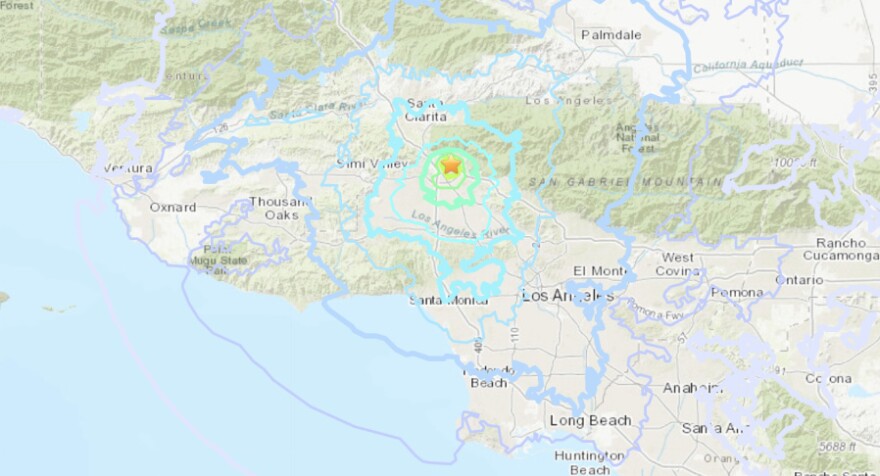With our free press under threat and federal funding for public media gone, your support matters more than ever. Help keep the LAist newsroom strong, become a monthly member or increase your support today.
A 4.2 Magnitude Earthquake Rattles LA, Followed By Dozens Of Aftershocks

A 4.2 magnitude earthquake struck L.A. in the predawn hours this morning waking Angelenos across the area. So far, it appears that more than 60 aftershocks have been recorded, but only a few have been large enough to notice.
The quake hit at 4:29 a.m, according to the U.S. Geological Survey, and was centered near the northern San Fernando Valley neighborhood of Pacoima — just west of the 210 Freeway. A short sharp jolt hit residents near the epicenter, while those further away felt longer, rolling waves, typical of what’s experienced during quakes.

An earthquake early warning was issued, according to the USGS, which gave those signed up for the service up to a six second warning that the shaking was coming their way. Those closest to the quake likely did not receive an alert before shaking reached them.
Here in Northridge, about ten miles from Pacoima, we were awoken by the shaking, rattling of our blinds and movement of tchotchkes strewn atop the dresser. It felt like a truck hit the house.
The L.A. Fire Department immediately went into Earthquake Emergency Mode to survey the area hit by the quake. According to Mayor Eric Garcetti, no significant damage has been observed.
A magnitude 4.2 earthquake based in the San Fernando valley shook L.A. at 4:29 a.m. Our @LAFD has conducted its routine assessment for any damage in the city. No reports of significant damage or injury. https://t.co/d2niauLdzF
— MayorOfLA (@MayorOfLA) July 30, 2020
While the quake was relatively small, it doesn't take a Big One for a shaker to cause significant damage when a highly populated area like the San Fernando Valley is hit. There are a number of faults running through the area that are capable of producing temblors the size of the supremely destructive Northridge quake.
The epicenter of the quake was an estimated 5 miles beneath Pacoima. By comparison, the 6.7 magnitude Northridge earthquake, which struck along a different fault, was 11 miles deep.
The information about the magnitude and depth is preliminary and could change as more information becomes available.
There's also about a 5% chance that this quake is a foreshock and a larger quake could follow it, though the likelihood will decrease the further we get from the initial event.
That's what happened last summer in Ridgecrest when the largest quakes in Southern California in many years hit back-to-back . The first, on July 4, was a magnitude 6.4. It turned out to be a foreshock of a 7.1 magnitude quake that struck on the evening of July 6.
Caltech seismologist Jen Andrews told us to expect the shaking to continue:
"It is likely that we'll have some more magnitude 3s. So certainly those people living in the San Fernando Valley will probably feel those as a weak shake. So,people should be expecting to feel those in the next sort of, yeah, days to maybe a couple of weeks"
THE BIG ONE IS COMING. GET PREPARED
We don't want to scare you, but the Big One is coming. We don't know when, but we know it'll be at least 44 times stronger than Northridge and 11 times stronger than the Ridgcrest quakes last year. To help you get prepared, we've compiled a handy reading list
- Your Guide To Surviving The Big One
- What If A Big Earthquake Hit California Right Now?
- For Earthquakes, Forget The 'Go-Bag.' Here's How To Prepare
- How To Not Get Life-Threatening Diarrhea After A Major Earthquake
- 10 Earthquake-Related Questions To Ask Your Landlord Immediately
- Listen to KPCC's Podcast The Big One: Your Survival Guide







